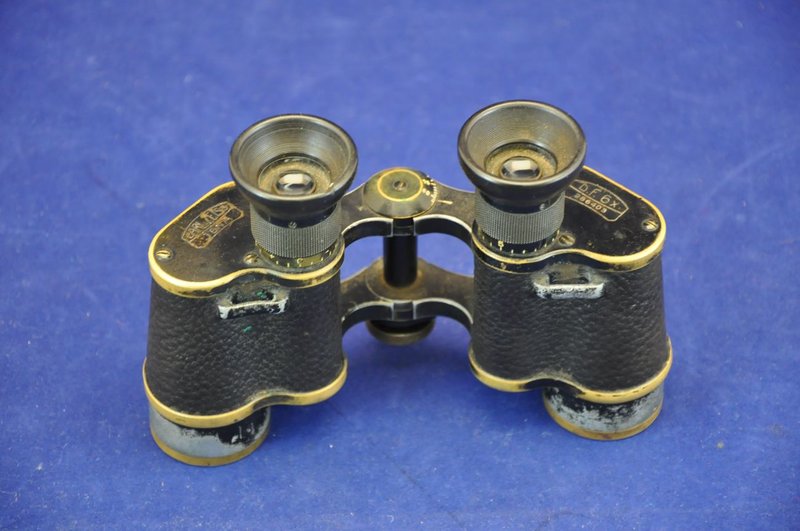

There is also an inscription “DIENSTGLAS D.F.6x 840739” on the right prism cover. There are inscriptions “Carl Zeiss Jena” on the left prism cover. The eyepieces base diameter is equal to 20.5 mm. The upper prismatic cover width is 45.5 mm the binocular height from lens frames’ lower cut to upper prismatic cover is equal to 69.3 mm. The eyepieces grooves (knurling) are angled to each other (“diagonal” knurling), the eyepieces have a diopter scale for acutance adjustment. The interpupillary distances scale is indicated on the upper hinge disk. The binocular’s “military" application is also proved by the large diameter of the central hinge clamp (lock) (see photo).
#Carl zeiss jena binoculars d.f. 6x serial number#
The serial number is 840739 and there is no additional military acceptance number. The presented binocular refers to the last, 4th version (with rounded objective covers) and it was released in 1916 as a 2000 pieces batch. Ģnd version: 6x21 - the one with double-ring type lens frames (starting from 1908/1909) ģrd version: 6x24 - the one with double-ring type lens frames (starting from 1911/1912) Ĥth version: 6x24 - the one with rounded objective covers (starting from 1913). Nearly 6,000 specimens were produced with such design option. There are several major modifications of this model:ġst version: 6x21 - the one, where the lens frame and the lower prismatic cover are made as one component (starting from 1906/1907) and having the eyepieces case with the “transverse” knurling (see photo). This device became the most popular military binocular of the First World War and its release stopped in the 30s of the last century, before the Second World War. The new version of military binocular D.F.6х (its old version is available by the following link: ) appeared a little bit earlier than its “civil twin” – namely Telex binocular -, around the end of 1906. In addition, the prisms inside the binocular were no longer pressed by prismatic covers, but they were fixed with special flat springs, which increased the device reliability significantly. Optical characteristics were significantly improved for the new devices (field of view and the lenses diameter were increased, while optical aberrations were reduced), and the devices’ construction was also changed: the central hinge and the “ears” for the neck strap were not attached to the binocular with the help of screws any more - they became the whole part with it instaed, an eccentric lens alignment system appeared and the design of its frame changed, prism covers spanned the binocular body and they were lubricated with a special compound at the joints with the purpose of tightness improvement. The presence of a distance meter grid (see photo) is a rare peculiarity of this old military binocular, which has serial number “2472” and was manufactured approximately in 1904.In 1906-1907, Carl Zeiss radically changed the construction and the design of his binoculars (both “civilian” and military ones). It is most likely that the binoculars coffer has a later origin (see photo) The inscription is encrusted with silver (?) alloy and is made in italics. At the same time, military binoculars with inscriptions in italics were manufactured until 1907. It is worth mentioning that starting from 1904 an inscription in italics was replaced by an inscription in printed letters and the Carl Zeiss logo on Tessar photographic lens scheme background in civilian binocular models. This model was also officially purchased for the army, mainly for sergeant staff. The last inscription means that the binocular has its own number for selling exclusively to military people and in a private order with the permission of military department. There is also an inscription “D.F.6х P.№5751” on the right prism cover and it is an abbreviation for Doppelfernrohr 6х Privatnummer 5751.

is an abbreviation for Deutsches Reichs Patent. There are inscriptions “Carl Zeiss, Jena. The upper and lower prism covers are made of brass the device has long “lugs” for a jugular strap, which are attached to binoculars with the help of 2 screws. The binoculars frame hinge is attached to its halves with the help of 5 screws from each side. Zeiss-Feldstecher, Handfernglaser von 1894-1919, Modelle-Merkmale-Mythos, pp.180-181).

Since 1902 the binoculars were completed with “3/3”-type eyepieces, having a diopter scale (see Hans T.Seeger. The binocular’s field of view was also increased: from 6.2° to 6.8°. Moreover, the eyepieces’ base diameter in D.F.6х is equal to 20.5 mm and the upper prism cover width is 44 mm (these values are correspondingly equal to 18 and 40 mm for O.D.F.95). For example, the clamping screw for adjusting the interpupillary distance has another construction in D.F.6х.


 0 kommentar(er)
0 kommentar(er)
